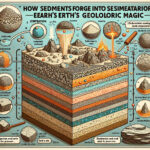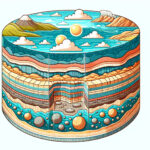Introduction to Sedimentary Rock Formation
Imagine you’re a detective piecing together a jigsaw puzzle that is the Earth’s history. Your most valuable clues? Sedimentary rock layers! These geological whispers from the past are like pages in a storybook, telling tales of ancient environments and the life that once thrived there. Sedimentary rocks are, in fact, Earth’s historical archives, and understanding their formation is like unlocking the secrets of time itself.
Sedimentary rocks begin their journey as mere particles – fragments of minerals and organic matter that traveled over land or settled down in the beds of ancient seas, rivers, and lakes. Over time, these particles accumulate layer upon layer, like the years stacking upon a timeline. Each layer is a snapshot of a specific era, preserving a wealth of information about the Earth’s conditions at the time it was deposited.
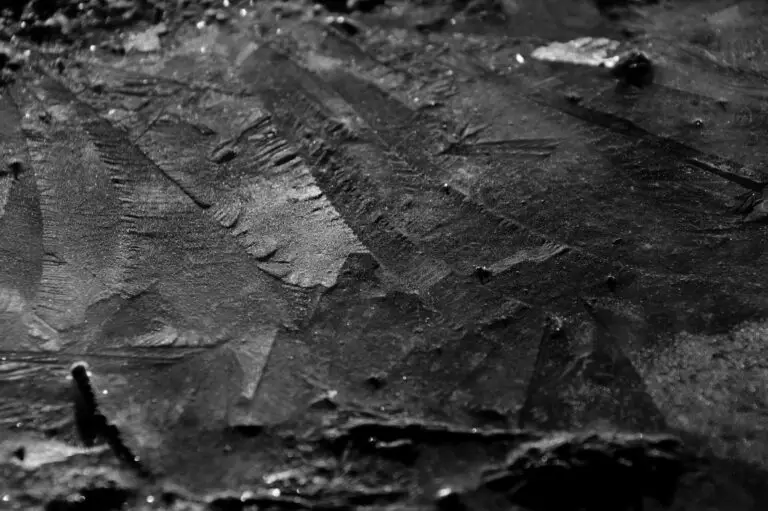
Picture a tranquil river slowly carving its way through the landscape, carrying with it grains of sand and mud. As the river reaches a calm basin, these grains settle to the bottom, bidding farewell to their nomadic lifestyle. Here, they may meet remnants of marine life, falling leaves, or even volcanic ash – an eclectic mix of characters, each adding their own flair to the emerging sedimentary layer.
But the story doesn’t end with sediments just lying around; no, there’s drama beneath the Earth’s surface! Over thousands or millions of years, these layers undergo lithification – a transformative process involving compaction and cementation. The weight of overlying layers compresses the sediments, squeezing out water and air, bringing grains closer together. Then, with natural cements such as calcite or quartz, these particles are bound together to form solid rock, immortalizing the conditions of their formation.
Through the meticulous study of these layers, we can deduce not only the environment but also the climate of the past. We can identify periods of major geological events, such as floods or droughts, and even track the migration patterns of ancient species. In essence, these layers are nature’s way of chronicling its own evolution.
To hold a piece of sedimentary rock is to hold a piece of Earth’s history in your hands. So the next time you come across these stratified marvels, remember: You’re not just looking at a rock; you’re gazing upon the echoes of an ancient world, patiently waiting to share its story with anyone willing to listen.
The Birth of Sedimentary Rocks: Weathering and Erosion
Picture this: the grandiose mountain peaks, etched and sculpted over eons—not by the hands of a master artist, but by the relentless forces of nature: weathering and erosion. These are the unsung heroes in the epic of sedimentary rock formation. It all begins with the relentless breakdown of pre-existing rocks through weathering. Think about it as nature’s mallet and chisel, gradually carving bits and pieces off larger stone edifices.
Now, let’s take weathering. It’s a bit like a celebrity makeover, but for rocks. Over time, rocks are exposed to air and water, temperature changes, and biological factors, all of which contribute to their alteration. It could be something as gentle as the slow dance of water seeping into cracks, only to freeze and push the rock apart. Or it might be as fascinating as plant roots wedging into stone, prying it open in search of nutrients.
Then there’s erosion, the trusted sidekick to weathering. Once the rock particles lose their bonds during weather events, erosion steps in to whisk them away. Imagine flowing rivers acting like conveyor belts, transporting the weathered debris downstream. It’s the grand relocation project of the natural world, where particles are carried to new locations, only to settle and, over time, become potential candidates for future sedimentary rock stars.
One compelling example of erosion can be seen in the Grand Canyon—a marvel of rock layers, telling a story millions of years in the making. As the Colorado River sliced through layer after layer of rock, it exposed the history of the Earth’s crust like the pages of a book. But not just any book, this is one of the greatest geological archives on the planet.
In essence, sedimentary rocks are the world’s natural historians, capturing snapshots of environmental conditions, from ancient river deltas to long-vanished deserts. These snapshots tell a story—a story that begins with the simple yet fascinating processes of weathering and erosion.
Journey of Sediments: Transportation to Deposition
Imagine yourself on a serene riverbank; tiny grains of sand glide along with the ripples of the water. Now, let’s shift this perspective and follow the odyssey of these very sediments as they embark on a transformative journey, eventually becoming part of Earth’s ever-evolving geological narrative.
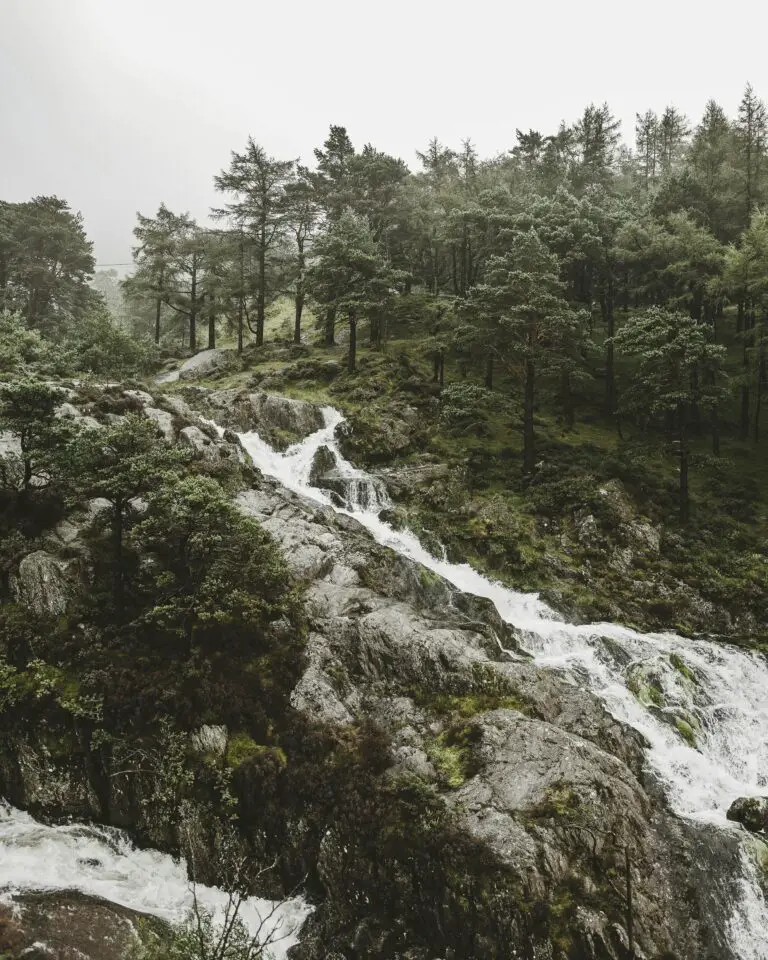
The saga begins with weathering – nature’s way of breaking down rocks into smaller fragments. As these fragments are freed from their rocky strongholds, a process called erosion kicks in. Wind, like an artist’s brush, sweeps across arid landscapes, sculpting dunes from microscopic dust particles. Meanwhile, glaciers, those colossal ice architects of the past, grind their way over the land, pulverizing rocks beneath their frosty weight.
But it’s water that serves as the highway for sediment transportation. Picture the grandeur of a river coursing through a canyon, carrying with it a symphony of sediments. These grains of ancient lands hitch a ride on water’s currents, twirling and tumbling from mountain rivulets to expansive deltas. Along the journey, they’re sorted by size – sand settles swiftly, while clay takes a leisurely float downstream.
Eventually, these traveling particles find repose as they sink to their final resting place – the site of deposition. In a lake, fine silts settle into a soft bed, while oceans welcome sands to their vast seabed expanses. Over time, layer upon layer is added, as if the waters themselves are leafing through the pages of a stone-strewn book.
It is here, in this aquatic library, that sediments begin their metamorphosis into sedimentary rocks. Under the immense pressure of accumulated layers and the knitting chemistry of minerals within groundwater, these once transient particles cement into a coherent whole, narrating Earth’s history through striated lines.
Curious to dive deeper into the Earth’s lithic secrets? Explore the fascinating world of sedimentary rocks and their formation with this educational information from the National Geographic Society.
Witness this mesmerizing act of geology; an ever-ongoing process whereby nature’s artisans – the wind, water, and ice – craft the very ground beneath our feet. Just as a tale unfolds through the words on a page, Earth’s story is unveiled layer by layer, in the grand book of sedimentary rocks.
“`html
Layers upon Layers: Depositional Environments
Imagine Earth as an enormous, dynamic canvas, with nature as the artist tirelessly at work. Over millennia, this artist has painted breathtaking layers of sedimentary rocks, capturing the essence of time itself within stony pages. Let’s delve into the birthplaces of these geological marvels, where the intricate process of laying down sediments transforms landscapes into stratified archives.
River Deltas: Picture the mighty rivers of our planet, weaving their way through continents and carrying with them the weight of eroded material. As these rivers meet the ocean, they slow down, dropping their burdens and creating deltas. These deltas are sedimentary nurseries, where fine grains settle out to form delicate layers rich in organic matter. Over time, these layers get compacted, ushering in the birth of rocks like shale that narrate the tales of ancient aquatic highways.
Oceans: Dive into the vast, blue expanses of our oceans, the grandest of all depositional environments. Here, sediments travel far and wide, settling into quiet, dark depths. Calm and steady, these underwater realms foster the formation of limestone, dolomite, and chert—rocks that often harbor fossils of long-gone sea creatures, linking us to vanished underwater worlds.
Lakes: Step aside from the ocean’s immensity and peer into lakes, the smaller yet no less intriguing cousins in the realm of sedimentation. In these often tranquil settings, fine sediments drift down through still waters, forming delicate laminate structures called varves. With each passing season, a new layer settles, encoding climate patterns and ecological shifts within its confines—the very essence of history trapped in stone.
Each depositional environment lays down sediments with distinct characteristics, and it is through understanding these delicate and complex formations that we begin to unravel Earth’s enigmatic past. These formations are not just rocks; they are libraries of our planet’s history, waiting for the keen eyes of geologists to read their stories. And should you be keen to learn more about the characteristics of sedimentary rocks, you’ll find yet another chapter in Earth’s captivating saga.
“`
Turning Sediments into Stone: Lithification
Imagine you’re walking along a serene beach. As you stroll, the waves lap gently against the shore, depositing layers of sand, shells, and pebbles at your feet. These materials, carried from lands afar, are on the cusp of an epic geological journey that will transform them into a marvel we call sedimentary rock.
Now, let’s dive into the earth-shaping process of lithification. Picture those beach sediments beginning to pile up, layer upon layer. Over time, they are buried under additional materials, becoming deeply ensconced in the Earth’s crust. The weight of the overlying sediments exerts immense pressure, squishing the grains in a process known as compaction. Much like squeezing water out of a sponge, this pressure forces out water and air between the grains, bringing them closer together.
Compaction alone doesn’t solidify these particles into stone. Enter cementation, nature’s glue factory. Groundwater percolates through the compacted sediments, rich with dissolved minerals. As it moves, the water precipitates these minerals, which crystallize and bind the sediments together. The result? A conglomerate of grains now locked in a solid embrace, creating the sedimentary rock layers that chronicle Earth’s history.
One captivating real-life example is the iconic Grand Canyon. This natural wonder exposes a mesmerizing sequence of sedimentary layers, each telling a story millions of years in the making. To envision how lithification crafts such stunning formations, think of these rock layers as pages in a book—each one a snapshot of an ancient world, filled with clues about past environments, climates, and life forms.
Even the 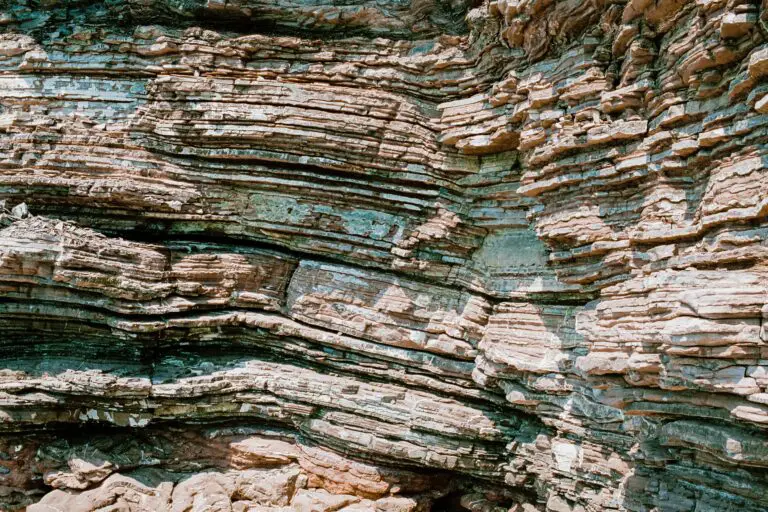 most commonplace stones under our feet are records of such transformative journeys. Capturing the essence of our planet’s dynamic character, lithification is a fundamental process, cementing not only sediments but also the narrative threads of our planet’s intricate past.
most commonplace stones under our feet are records of such transformative journeys. Capturing the essence of our planet’s dynamic character, lithification is a fundamental process, cementing not only sediments but also the narrative threads of our planet’s intricate past.
For more intriguing insights into the marvels of our planet, explore the world of earth sciences where the story of life is etched in the very stones we tread upon.
Reading the Pages of Time: Stratification and Dating
Imagine leafing through a colossal book with each page telling a story of the past, and you’re just about to grasp the essence of sedimentary rock layers. In our geological tome, the tales are told through stratification, the natural process of layer upon layer of sediment solidifying over eons to form sedimentary rocks. So, how does this process unmask the Earth’s deep history?
Enter the Law of Superposition – the who’s who in the world of geologic principles. Simply put, it states that in an undisturbed sequence of rock layers, the oldest layers are at the bottom, with younger layers successively above them. Think of it as a time machine that’s laid out flat, with earlier chapters at the foundation, and each subsequent layer akin to turning a page in Earth’s long narrative.
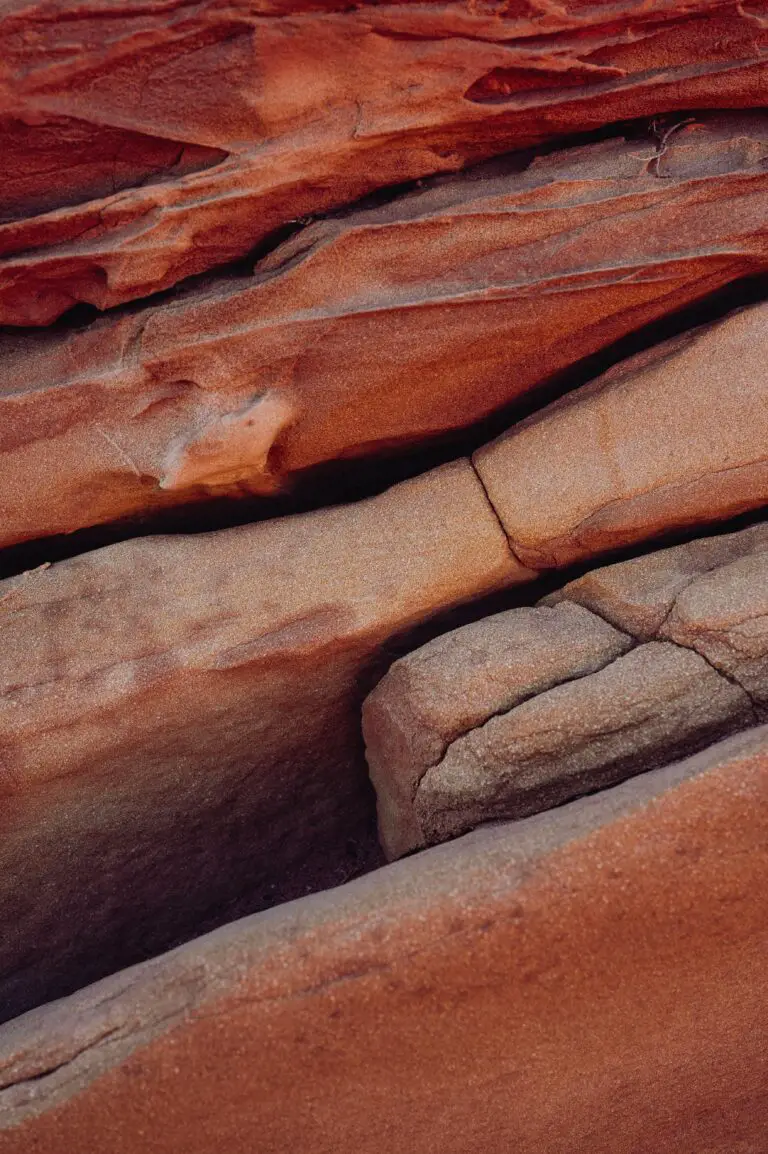
But just how do we “read” these pages to find out the age? This is where the thrilling detective work comes in—dating the sedimentary layers. We’re not talking candlelit dinners but rather using tools like radiometric dating to decipher the age of the rocks. By measuring the decay of radioactive elements within the layers, scientists can determine how much time has passed since those particles were last exposed to heat or sunlight—kind of like checking the timestamp on a long-buried message.
With real-life examples, stratigraphy shines its brightest. Take the iconic Grand Canyon, a majestic natural archive where each stratum uncovers tales of ancient rivers, vast deserts, and tropical seas. Here, layer upon layer forms the grand staircase of time, allowing us to walk through millions of years with each descending step.
The study of sedimentary rock layers is far more than academic—it’s a narrative etched in stone, revealing the dynamic processes that have sculpted our planet. It reminds us that, in the vast span of geological history, the story of Earth is still being written, and with each uncovered layer, we’re invited to explore its most profound chapters.
A Mosaic of Types: Classifying Sedimentary Rocks
Imagine Earth as a master storyteller, each layer of sedimentary rock a page in its vast geological diary. These layers not only reveal the secrets of Earth’s history but also tell tales of the environments from which they emerged. But not all sedimentary rocks are created equal. Like the chapters of a book, each type offers a unique story, and understanding their classifications—clastic, chemical, and organic—is key to unraveling Earth’s narrative.
Clastic Sedimentary Rocks: Picture walking along a gravelly riverbank. The various sizes and shapes of the pebbles beneath your feet are a testament to the journey they’ve undertaken. Clastic sedimentary rocks form in a similar fashion, as fragments of older rocks—known as clasts—are transported by water, wind, or ice. Over time, these fragments settle in layers and compact under pressure to create rocks like sandstone and shale. Next time you see a building clad in sandstone, consider the long journey its materials have made from mountains to architectural marvel!
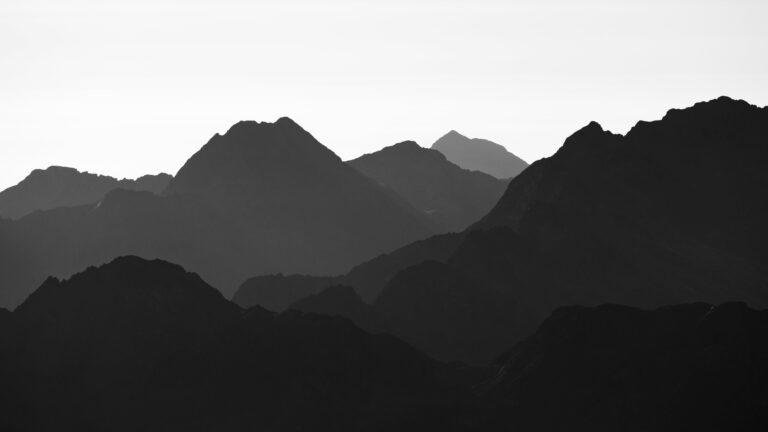
Chemical Sedimentary Rocks: Let’s dive into a salt lake or a mineral-rich hot spring. As the water evaporates, it leaves behind a bounty of dissolved minerals. These minerals crystallize, layer after layer, forging rocks such as limestone and halite. The White Cliffs of Dover stand as a grand example, flaunting their massive limestone faces that once formed on ancient seabeds, capturing within them the essence of marine life long past.
Organic Sedimentary Rocks: Now, venture into the deep, dark swamps and coastal lagoons, where the remains of plants and animals settle into the murky waters. Here, organic matter is compressed and decomposes over geological timescales, giving rise to rocks like coal and oil shale. These sedimentary rocks are the altered remains of ancient forests and microscopic creatures, providing not only a window into primeval Earth but also fueling the modern world.
The origin and appearance of sedimentary rocks paint a vivid mosaic of our planet’s environmental and biological history. Clastic rocks convey tales of erosion and travel, chemical rocks crystallize from mineral-rich solutions, and organic rocks emerge from the remains of life itself. Each rock type is a unique piece of the puzzle that helps to decode the intricate storyline of our ever-changing Earth.
Unlocking Past Climates: Sedimentary Structures and Fossils
Imagine being a detective, but instead of solving crimes, you’re piecing together the history of our planet. Sedimentary rock layers are like pages in Earth’s own thrilling mystery novel, and it’s our job to read between the lines. Let’s dive into the captivating evidence that sedimentary structures and fossils present, allowing us to unveil the secrets of past climates and environments.
Take a stroll along a sedimentary cliff and you’ll notice something remarkable: bands of rock that seem to hold whispers of ancient times. Each layer, with its unique texture and composition, tells a story of an era long gone. What caused a sudden shift from fine sand to coarse pebbles? Perhaps a swift river once flowed here, its current strong enough to carry larger sediments. These structures aren’t just random; they’re clues to the environmental conditions when those sediments were deposited.
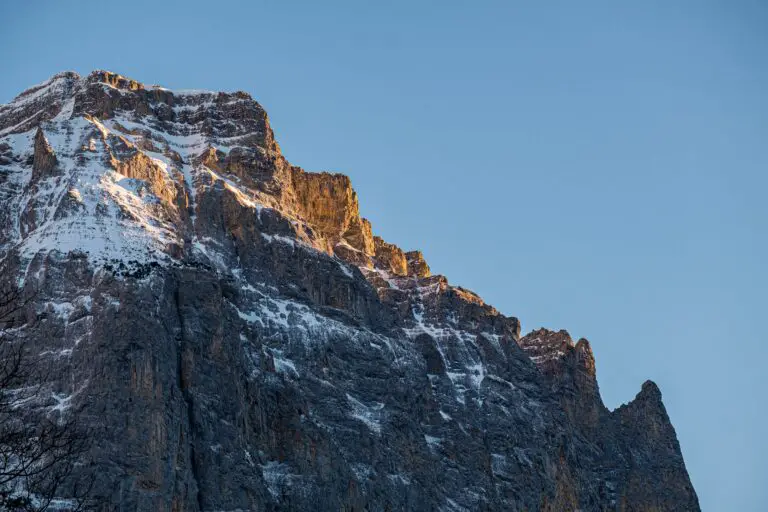
As we pore over these sedimentary pages, we often also find the remains of life from yesteryear—fossils. Fossils aren’t just the bones of dinosaurs we see in museums; they encompass preserved traces of all life forms, from the tiniest marine organisms to the largest land mammals. They are the biological breadcrumbs that lead scientists to reconstruct ancient climates. You’d be amazed by how a single fossilized leaf can hint at tropical conditions in what is now a frozen tundra!
Understanding sedimentary rock layers and fossils isn’t a trivial matter. They are critical in resolving the puzzle of Earth’s shifting atmospheres. Did towering trees once dominate where deserts now stretch? Was there a time when ice sheets didn’t cover the poles? Thanks to sedimentary markers and the life forms etched in stone, we unravel these mysteries. It’s a profound reminder that our planet is ever-changing, and by studying these archives, we can prepare better for the environmental challenges ahead.
Humanity’s Resource: The Economic Significance of Sedimentary Rocks
When we ponder the materials that make up our modern world, it’s easy to gloss over the mundane and focus on the flashy. But it’s the unsung heroes of geology, particularly the sedimentary rocks, that quietly form the bedrock of our civilization—quite literally. Ever noticed the gravel beneath your feet as you walk down a countryside path or the cut stone adorning the façade of an exquisite building? Chances are, you’ve encountered the silent yet steadfast sedimentary rocks.
From Foundations to Skyscrapers: Sedimentary Rocks in Construction
Picture the grand limestone buildings that stand as testaments to our architectural prowess through the centuries. The Great Pyramids of Giza, the Empire State Building, and a myriad of cathedrals across Europe—they all share a common thread woven from sedimentary rock. Limestone and sandstone are not merely decorative; their durability and ease of carving have made them the cornerstone of construction since ancient times.
A Spark in the Dark: Energy Production
Beyond their aesthetic and structural contributions, sedimentary rocks are also power players in the energy sector. Take, for example, coal—a sedimentary rock name-dropped in every history book detailing the Industrial Revolution. It lit up our world and powered our progress. And even now, although cleaner energy sources are taking the limelight, sedimentary rocks still play a role, with natural gas and oil reservoirs often found in sedimentary basins.
The Treasures Within: Valuable Minerals
Now, let’s delve deeper—quite literally—into the realm of precious metals and rare minerals often recovered from sedimentary deposits. From the gleaming silver in our jewelry to the copper wires that crisscross the globe facilitating communication, these treasures often start their journey to us nestled within layers of sedimentary rock. When we talk about mining for resources, it’s this type of rock that often harbors the desired commodities.
Sedimentary rocks, far from being mere layers of compressed silt and sand, are indeed the building blocks of our society. They provide not just foundational materials for our structures but also the very resources that fuel and embellish our lives. Understanding how sedimentary rock layers form gives us insight into a realm that is both incredibly ancient and incredibly vital to our modern existence.
Frequently Asked Questions
Got questions on the formation of sedimentary rock layers? You’re not alone! Let’s dig into this rocky business and unearth some answers.
What Sparks the Birth of Sedimentary Rock Layers?
Think of sedimentary rock layers as Earth’s history books. Just like chapters in a story, each layer marks a different episode in our planet’s past. It all starts with sediments – tiny pieces of minerals and organic matter. When these sediments hitch a ride on water, wind, or ice and settle down in layers, over time, pressure and minerals glue them together, forming sedimentary rocks.
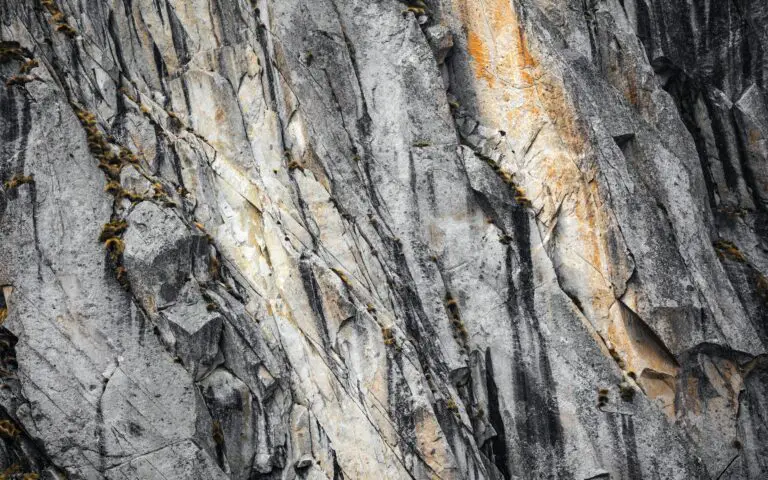
Can We Spot Sedimentary Layers In Real Life?
Absolutely! Take a stroll down the Grand Canyon or peer at the cliffs along a raging river. What you’re seeing are pages of Earth’s diary, stacked high. These visible stripes are silent storytellers, whispering tales of ancient rivers, mammoth lakes, and creatures that once roamed the depths.
Why Are These Rock Layers Crucial?
Beyond their stunning façades, sedimentary layers are scientific goldmines. Geologists study these layers to decode Earth’s climate from aeons ago, locate water and oil reserves, and even predict future geological events. Simply put, these layers hold secrets to our past and keys to our future.
Do Sedimentary Rocks Have A Life Beyond Layers?
Of course, they do! Sedimentary rocks don’t just pile up; they also erode and reform, entering a cycle that can lead to coal beds powering our homes or limestone fortifying our buildings. They’re an enduring testament to the adage: what’s old can be new again.
